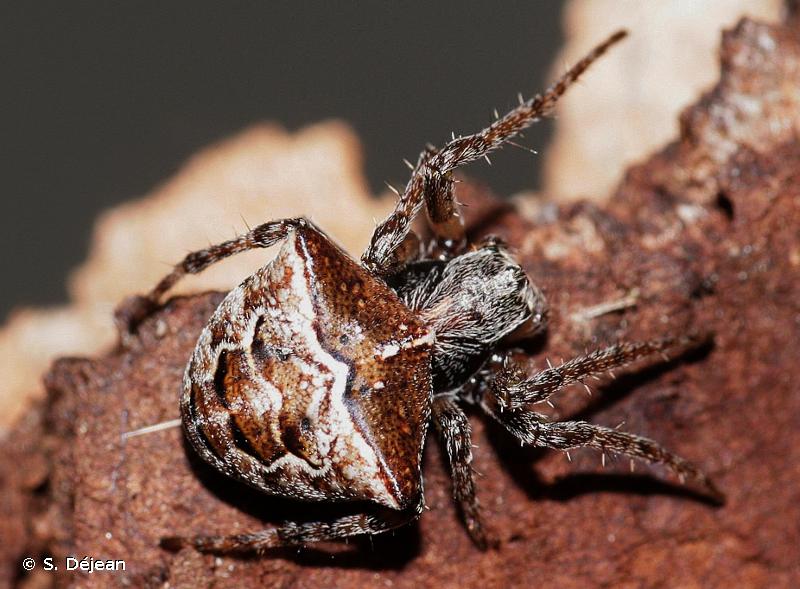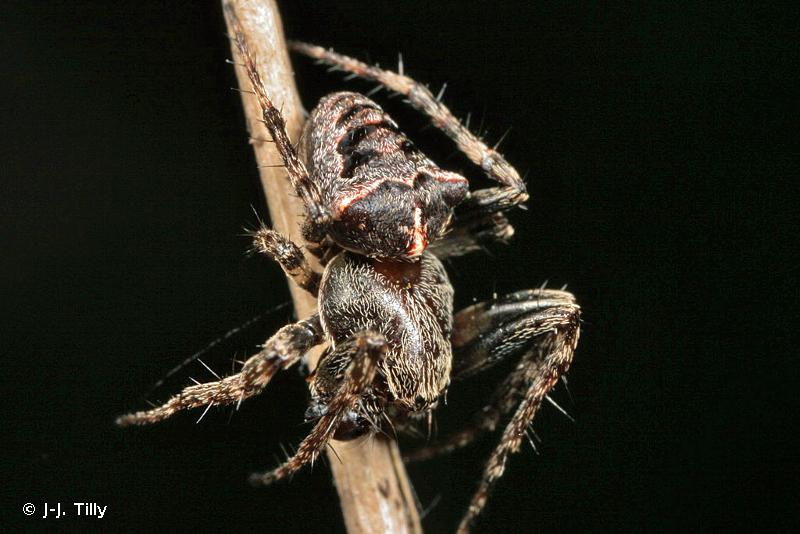
cd_nom

| Author : J-J. Tilly |
 |
To get the picture, please visit:
Jean-Jacques Tilly
Association française d'Arachnologie
http://asfra.fr/Site/Main_public.html
email : inpn@mnhn.fr
Legend: Mâle
Any reuse of one or more photographs on this site is subject to an authorization request from the author.
Link to the Code of Intellectual Property (Legifrance)

| Author : S. Déjean |
 |
To get the picture, please visit:
Despite the Creative Commons license, please inform the author of the use which will be made of his photo

| Author : J-J. Tilly |
 |
To get the picture, please visit:
Jean-Jacques Tilly
Association Française d'Arachnologie (ASFRA)
inpn@mnhn.fr
Despite the Creative Commons license, please inform the author of the use which will be made of his photo
Distribution mondiale
Europe, Bassin méditerranéen
Caractères distinctifs, espèces
Taille - femelle : 6-9 mm, mâle : 5-6 mm.
L'abdomen possède des pointes antérieures latérales et un dessin dorsal variable avec des couleurs plutôt brun à jaune, ce qui la distingue de l'Epeire gibbeuse (G. gibbosa) qui est plutôt verdâtre, et qui colonise, elle, plutôt les arbres et arbustes. Le genre comprend 4 espèces, les deux autres non encore citées (G. omoeda et G. ullrichi) sont difficiles à distinguer de G. bituberculata sans l'observation des pièces génitales. On pourrait la confondre avec l'Epeire angulaire (Araneus angulatus) qui est beaucoup plus grande, à pointes moins marquées, à dessin abdominal plutôt brun, et qui tisse sa toile en hauteur dans les arbres.
Milieux colonisés
milieux herbacés ensoleillés
L'Epeire dromadairecolonise des terrains secs avec une végétation éparse : friches, landes, steppes, garrigues, lisières de bois.
Chasse
La toile, construite le matin, est située assez bas dans la végétation. Elle est tissée entre deux tiges végétales, son centre est rarement à plus de 50 cm au-dessus du sol. Le jour, l'araignée reste sur la toile. Dans les régions chaudes, elle se cache dans une retraite, souvent construite sous une inflorescence haute (par exemple, Ombellifère).
Développement, cycle
Le cycle est annuel. Les adultes sont présents d'avril à juin. Les femelles peuvent pondre plusieurs fois, en juin. Le cocon est abandonné sur des tiges hautes de la végétation. Il est recouvert d'une soie épaisse. Les jeunes sortent des cocons après une vingtaine de jours, ils sont subadultes à l'entrée de l'hiver.
A. Canard(Université de Rennes/Service du Patrimoine Naturel, MNHN),2014
Continental
Metropolitan France
Overseas
Marine
Metropolitan France
Overseas
The map presents a summary at the 10 x 10 km grid of the observation data for the species transmitted to the SINP. These data have been subjected to validation filters.
The map presents a reference distribution layer of the species at the scale of departments and marine sectors. The presence and absence data were established by expertise within a network of partners. This reference distribution is used in the validation process of the SINP data at the INPN level.
Corresponds to a report on the basis of at least one observation proved within a period of 10 years (20 years for little-known invertebrates) preceding the year and no presumption of extinction since obtaining the last data nor doubt on reproductive and implemented nature of this population. For migratory species, the presence indicated concerns areas of reproduction.
This status is based on one or more of the following criteria:
This point covers the absence, more difficult by nature to demonstrate than presence. This status is based on one or more of the following criteria:
This status must be assigned to a department in which the presence of the species is casual.
Particular case of absence due to a proven extinction less than a half century ago (older disappearances are treated as "no probable or definite").
In the state of knowledge, we can not comment on the presence or absence in the current department. This is the default status when not comprised in one of the previous categories or whenever there is doubt.
The map shows the global distribution of the species based on GBIF data (Global Biodiversity Information Facility).
